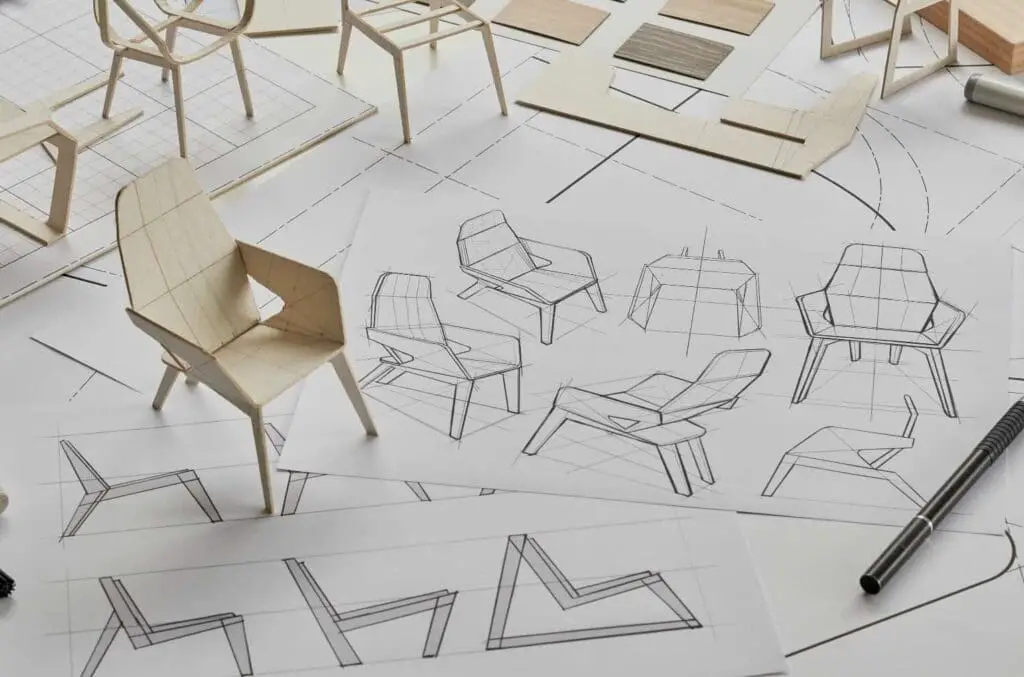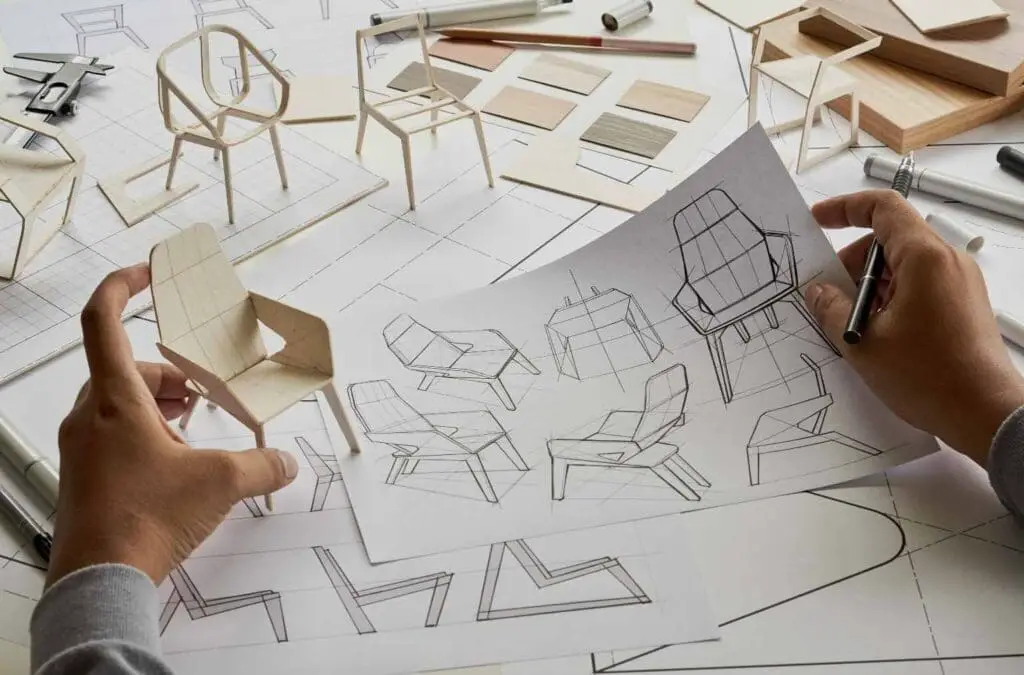Many designers and furniture companies ask how to protect their furniture and other designs from being copied. This is a worry of designers and creators everywhere.
You can protect your furniture designs by ensuring those you show them have a contract to view them and not copy them; also, make sure the designs are all dated and documented to show they are your original designs. A utility or design patent is a way to protect your designs legally and is one of the most time-consuming and expensive ways to protect your designs and work.
Table of Contents
You only need to walk the halls of a furniture trade show like the High Point Furniture Market In High Point, North Carolina, to see how difficult it is for a company or designer to protect their designs from being copied. There can be so many “similar” looking designs and sometimes even products shown in the same hallway that are outright copies.
Design Protection Options Explained
The truth is it can be tough to protect your furniture designs. Especially if someone will take your design and then change it or use the inspiration for their own design. This can be much harder for you to control or prove.
This is because it is actually very little in the furniture design world that is actual “creations.” Many designs are “inspirations” in that someone will see something they like as an old antique or a competitor’s product and use that as a basis for their design.
This happens a lot in the home decor and home furnishing industry. That is why when you walk the halls of a show like the High Point Furniture Market, there can be designs, shapes, colors, and finishes that seem to all be similar.
If you are an independent designer or a small company, it can be challenging for you to prove that a larger company or your competitor “stole” your design. The truth is that all this will be not only costly but also very time-consuming.
Document Your Work
One of the things you can do is make sure that your designs, work, and other things are organized and documented. Here are things that you can do to ensure this and help protect your designs:
- Date Designs With Dates – Make sure designs are date stamped or have a way to show a digital or electronic date. This can help you if you have to establish that it is rightfully your design legally.
- Noncompete Contracts – If you give your designs to a company to look at or view, sign a contract or noncompete agreement with them stating they can not use your work without permission. Keep this agreement in a safe place.
- Organize designs – Have all your designs organized and easy to find. This is of course, just good business and design sense; make sure you have everything organized in case you need to prove this is your design. If you sent the design to someone, keep the dated correspondence where you can easily find it and prove they had your designs and at what date or time it was sent to them.
Proving that someone copied you can be hard to prove unless they copied you 100% or used the same design you gave them. Changing the design, color, shape, and look can become complicated and more challenging to prove.
As a designer, creator, or company, you need to decide if waging this kind of fight against someone using your design is worth your time and effort. Sometimes, the best way to handle this is to talk to the person or company who offended you and see if you can get an agreement from them,
Other times, you can get a lawyer to send them a “cease and desist letter” along with the evidence to support your claim. I have found that most companies in our industry do not want to have the reputation of being someone who copies or cheats.

All Kinds Of Patents
When most people think about protecting their designs, they think about getting a legal patent on the design. There are two basic patents that people look at to protect their design: 1) a utility patent and 2) a design patent.
Even though they can seem to be similar, there are actually some differences between these patents. Not every design will fall under the qualifications and requirements to obtain either of these patents.
Utility Patent
When people think about protecting their furniture designs, they think about a patent. One of those kinds of patents is a utility patent. A utility patent is defined as:
“A utility patent is a patent that covers the creation of a new or improved—and useful—product, process, or machine. A utility patent, also known as a “patent for invention,” prohibits other individuals or companies from making, using, or selling the invention without authorization. When most people refer to a patent, they are most likely referring to a utility patent.”
Investopedia
You might read that and think, wow, that sounds great. I’m going to go out today, and I’m going to file a utility patent on all my designs. But, like most things, it is not as easy as it sounds or seems.
Here are a few things to remember about a utility patent
- For a utility patent, you must show the design is a new, improved, and useful product, process, or machine for the inventor to get exclusive rights. The key to all this is to show that it is your design and will meet all the criteria for a utility patent.
- Utility patents are valuable assets because they will give the holder exclusive rights to produce the product. If you plan to sell your product to a large company, they usually consider a utility patent an asset.
- Utility patents are difficult to obtain; obtaining one can take over three years. As the process is complicated, you will need a patent attorney or an agent to help you through the very complicated process of getting a utility patent.
- The U.S. Patent and Trademark Office issues a utility patent in the United States that can last up to 20 years. A utility patent also has maintenance fees associated with it.
- Utility patents are expensive to obtain. The filing costs (not including all the other miscellaneous costs) can range from 1,000 to 10,000 dollars. So, the process of getting a utility patent is very expensive.
- A utility patent will help protect your design from others copying it. But if they use your design as inspiration and do not copy it exactly, it can be harder to prove. And in any case, you will need to go through some legal process to stop this kind of action by another party.
The reality is that a designer or company must outweigh whether or not their furniture design warrants a utility patent. One, is it really new, or is it a design similar to other designs that may not even be allowed under a utility patent? Two, is the utility patent worth all the time it will require to get it? And, three, is it worth the expense as a utility patent will be expensive to obtain?
If you can honestly answer “yes” to all these questions, it may be worth the time and expense to get the patent. But the truth is that most furniture designs would not warrant getting a utility patent unless it is unique and is a design or creation that makes it worth this expense, effort, and time.
Design Patent
Another type of patent you can obtain is called a design patent. A design patent is similar but not the same as a utility patent. Here is the definition of a design patent:
“A design patent is a form of legal protection of the unique visual qualities of a manufactured item. A design patent may be granted if the product has a distinct configuration, distinct surface ornamentation or both. In other words, a design patent provides protection for the ornamental design of something that has a practical utility.”
Investopedia
Like a utility patent, a design patent is not always easy to obtain. Here are a few things to remember about a design patent:
- In the United States, if a design has a very similar look to another design with a patent, it cannot have a patent.
- Patent protection does not always automatically go to another country; the protection will depend on the laws of that country.
- A design patent filing will cost you less than a utility patent; the total cost can be 1,000 to 3,000 USD depending on the situation and how complex the design is (this amount does not include legal or other fees).
- A design patent will usually be granted for about 14 to 15 years.
- A design patent will safeguard how a design looks.
Neither a design patent nor a utility patent is very easy to obtain. They are both extremely costly and will take a lot of time to file and maintain.
If either of your patents is violated, there will be costs for you to defend the rights to your patents via the legal system. So unless you have a design that you really believe in or one that you feel warrants this kind of cost and attention, it is probably best that you do not go the route of trying to get a legal patent on your furniture design.

Instead, one of the best things I believe most designers can do is to continue to design. Come up with the next best design, as then it will be hard for people to keep up with you and your success.
The best furniture designers are trailblazers who always have their eyes and mind on creating the next great trendy design. The truth is that furniture designs and trends can change very quickly, so what is in demand today can become obsolete tomorrow.
Find out more about how Mondoro can help you create, develop, and manufacture excellent home decor and furniture products – don’t hesitate to contact me, Anita. Check out my email by clicking here or become a part of our community and join our newsletter by clicking here.
Mondoro gives out a FREE Lookbook to anyone interested. You can receive a copy of our latest Lookbook by clicking here.
Listen to our Podcast called Global Trade Gal. You can find it on all major podcast platforms. Try out listening to one of our podcasts by clicking here.
Subscribe to our Mondoro Company Limited YouTube Channel with great videos and information by clicking here.
Related Content
What Is The Difference Between Supply Chain Management and Logistics?
Supply chain management is about the collaboration and partnerships to get the goods from raw materials to the end consumer; it is about the partnerships and collaborations within this supply chain process. Logistics is one part of the supply chain management; logistics is about moving goods from one place to another. In some instances, the logistics providers will also store the goods and send them on to the end consumer.
You can learn more by reading our blog What Is The Difference Between Supply Chain Management and Logistics? by clicking here.
What Are The Benefits Of Supply Chain Management?
There are many benefits to supply chain management. The benefits of supply chain management include teamwork and collaboration, improved quality control, better efficiency and effectiveness, on-time deliveries, maximization of overhead costs, improved cash flow, risk mitigation, and shipping optimization. All of these areas are greatly helped by proper supply chain management.
You can learn more by reading What Are The Benefits Of Supply Chain Management? by clicking here.


